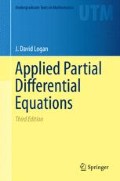Abstract
Many important ideas in mathematics are developed within the framework of physical science, and mathematical equations, especially partial differential equations, provides the language to formulate these ideas. In reverse, advances in mathematics provides the stimulus for new advancements in science. Over the years mathematicians and scientists extended these methodologies to include nearly all areas of science and technology, and a paradigm emerged called mathematical modeling. A mathematical model is an equation, or set of equations, whose solution describes the physical behavior of the related physical system. In this context we say, for example, that Maxwell’s equations form a model for electromagnetic phenomena. Like most mathematical models, Maxwell’s equations are based on physical observations. But the model is so accurate, we regard the model itself as describing an actual physical law. Other models, for example a model of how a disease spreads in a population, are more conceptual. Such models often explain observations, but only in a highly limited sense. In general, a mathematical model is a simplified description, or caricature, of reality expressed in mathematical terms. Mathematical modeling involves observation, selection of relevant physical variables, formulation of the equations, analysis of the equations and simulation, and, finally, validation of the model to ascertain whether indeed it is predictive. The subject of partial differential equations encompasses all types of models, from physical laws like Maxwell’s equations in electrodynamics, to conceptual laws that describe the spread of an plant invasive species on a savanna.
Access this chapter
Tax calculation will be finalised at checkout
Purchases are for personal use only
Notes
- 1.
Recall that the flux and source may depend on the density u as well.
- 2.
Terms like O(h 3) are called order terms and we read such terms as an order h 3 term. Precisely, an expression G(h) is order \(h^\alpha\) for small h if \(G(h)/h^\alpha\) remains bounded for all h sufficiently small, \(h \ne 0\).
- 3.
For concise notation, double and triple integrals are often written as a single integral with the region of integration as a subscript. The context should indicate the type of integral, two- or three-dimensional.
- 4.
Two common notations for the boundary of a set B are \(\partial B\) and \(\mbox{Bd}B\).
- 5.
In science and engineering texts, the Laplacian is often denoted by \(\nabla^2 u\).
Author information
Authors and Affiliations
Corresponding author
Rights and permissions
Copyright information
© 2015 Springer International Publishing Switzerland
About this chapter
Cite this chapter
Logan, J. (2015). The Physical Origins of Partial Differential Equations. In: Applied Partial Differential Equations. Undergraduate Texts in Mathematics. Springer, Cham. https://doi.org/10.1007/978-3-319-12493-3_1
Download citation
DOI: https://doi.org/10.1007/978-3-319-12493-3_1
Published:
Publisher Name: Springer, Cham
Print ISBN: 978-3-319-12492-6
Online ISBN: 978-3-319-12493-3
eBook Packages: Mathematics and StatisticsMathematics and Statistics (R0)

